
Amanda Vestergaard explores the reasons behind the lack of women in route setting, and what could be done to increase the number of female route setters in our gyms and competitions.
Ever since I started climbing, I have been surrounded by strong women. I was part of the generation that saw indoor climbing explode in popularity amongst both men and women, and grew up with idols such as Janja Garnbret, Shauna Coxsey, Sasha DiGiulian, Emily Harrington… the list goes on. So, when I started working as a route setter, the complete lack of female colleagues and role models to learn from came as a surprise.
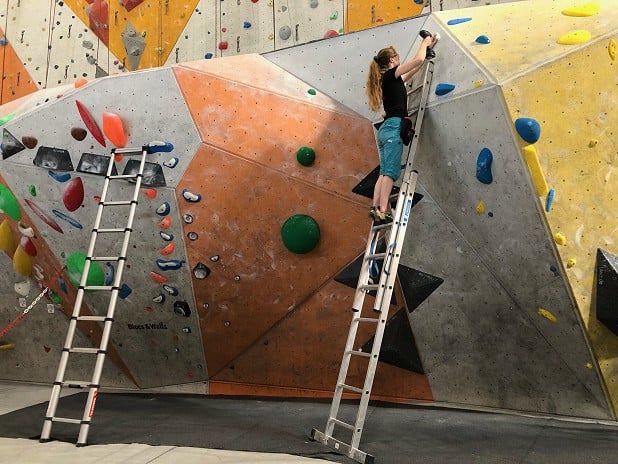
In 2019, about one third of climbers in the UK were women, with numbers rising since then. However, this growing female presence has been slow to translate into female participation in the route setting industry. In the same year, 29 out of the 30 IFSC route setters who worked the World Cup circuit were men. In my four years of route setting on a regular basis, I can count the days I have spent setting with other women on one hand. Where are all the strong women we see in the gyms, at the competitions and at the crags? Why are so few making the transition into route setting? To find some answers, I contacted other female route setters to discuss what it is like being a woman in the route setting world, how we can inspire more women to take part, and why it is important that we do so.
Meet the women: Hélène Janicot and Alise Zvigule
Having both come from the world of competition climbing, Hélène and Alise are today active members of the route setting community, in gyms and as well as at competitions. Although they have had very different paths into route setting, they now both serve as pioneering female route setters, paving the way for diversity and inclusivity within the community, and for future women who may follow in their footsteps.
Hélène began climbing at school when she was 10, and started joining competitions on the world stage throughout her teenage years. At the age of 25 she took a break from the competition scene, and found her way into route setting through the French climbing federation (FFME). To her, this was a natural transition from her competition climbing and coaching career. Since then, she has set at multiple international competitions, including the IFSC World Cup series. This season, Hélène returned to the IFSC circuit as a competitor, making finals at the Innsbruck Lead World Cup and placing 8th.
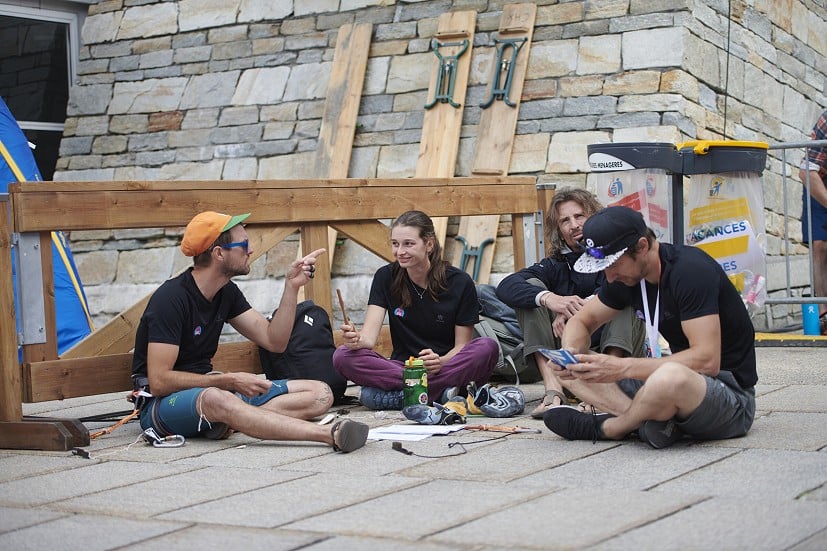
After becoming aware of the overall lack of women in the industry, Alise started route setting in her local gyms in the Netherlands. By her own admission, it took her a long time to get her foot in the door, and she is therefore all too familiar with the barriers women face when trying to enter this traditionally male profession. Today Alise is part of the IFSC Route Setters' Diversity Program, which aims to improve diversity among IFSC route setting members, with gender equality being a central focus. Meanwhile, Alise hosts workshops for women who want to improve their route setting skills, and creates spaces for women to set together in a collaborative and supportive environment.
To listen to Alise talk more about how and why she creates spaces for female route setters to build confidence together, listen to episode 118 of the podcast 'Bin Weg Bouldern', from which extracts formed the basis of her responses for this article.
What the f*ck is a girl boulder?
Over the past months, I have had a lot of conversations with fellow route setters on the topic of gender, not just in route setting, but within climbing as a whole. One day, my male colleague asked me a question which, until then, I had been too caught up in my own agenda to pose myself: why should we care if routes are set by a man or a woman? If a competent route setter is able to set for all body types, both short and tall, why does gender matter? My instinctive response was that of course gender matters?! But then I realised he had a point. Indeed, any claim towards the stylistic differences between male and female route setters would be an overgeneralisation. In the wise words of Alise, "what the f*ck is a girl boulder?"
Slowly, I came to the realisation that my personal crusade for female representation in route setting was not so much about gender as it was about diversity and inclusivity more broadly: if gyms are to welcome climbers from all walks of life regardless of physique, race ethnicity, as well as gender, route setting teams should reflect this. "Good route setting is about diversity," says Hélène.
Hélène thinks that "having women involved in setting can help include a lot more people", not just women. According to both Hélène and Alise, this is especially true for climbs at the harder end of gym circuits, as these have traditionally been set to favour taller and more powerful physiques. "You are a product of your environment," says Alise, insinuating that this bias within climbing gym circuits is preventing climbers with more diverse physiologies from breaking into the harder grades.
IFSC route setter Tonde Katiyo has spoken at length about his concept of 'athletic empathy', which he describes as 'the capacity to understand or feel what an athlete or climber is experiencing or capable of performing from within that athlete's frame of reference.' Diversity in climbing and in route setting specifically, he says, can help to broaden movement possibilities and consequently increase the fulfilment that people get from the sport.
Because route setters are highly visible characters within climbing gyms, and gain a lot of attention from gym members, they inadvertently take on the role of community leaders. They shape the gym environment, which in turn shapes the climbing community more broadly. In the end, good route setting may not be about gender. But inclusivity, openness and diversity within our community is, at least in part, reliant on female representation in the route setting sector.
Hidden systemic issues
To properly understand how other female route setters are currently experiencing the setting environment, I started out by asking Hélène and Alise how they personally experience day-to-day life as women within the route setting industry. I quickly found that their experiences resembled my own: while explicit gender-based discrimination within the job is rare, and male colleagues are most often kind and supportive, there are many systemic issues and biases which make it clear that this is still a gendered profession.
Although these issues are sometimes concrete and observable, as is the case when work equipment is somehow not designed to suit women, these issues most often manifest themselves as intangible dynamics that are hard to describe to people who have not themselves experienced them. Although belts with mile-long straps, work harnesses that cannot be tightened small enough, and unnecessarily gendered uniforms are serious problems that need to be addressed, it is these more immaterial but highly problematic work-place dynamics that tend to fly under the radar.
One such dynamic that both Hélène and Alise were quick to mention is the phenomenon of the 'token female route setter'. "Sometimes you feel you're not getting asked [to route set] because you're good at your job, but because they need to observe gender equality," says Hélène. Meanwhile, Alise is frustrated with the perception that women in the industry are there to tick a box. Mirroring Hélène's sentiment, Alise asserts that she wants to be hired "not because I am a woman, but because I am a good setter."
While the perception that women in the industry are there to fill gender equality quotas is frustrating in itself, being the token woman at a workplace can also feel like a lot of pressure. "When I show up for a setting job, I feel I am showing up for the entire community," says Alise, a sentiment I know all too well myself. Some days, it can feel like every mistake you make is a reflection not just on you, but on all women in the industry. Alise continues on a more positive note, saying that she "wants to do well for women who want to get into setting -— they see you."
Looking beyond ladders and power tools
Hélène and Alise's accounts of female tokenism hint at the fact that many of the problematic dynamics that exist within route setting today can only be overcome through increased female representation within the industry. But to properly understand how this can be achieved, we need to look at what it is that holds women back from entering the route setting workforce.
Speaking to friends and colleagues, I have often heard it said that the reason more women don't become route setters is because they feel less comfortable with ladders and power tools than men do, and that women are generally less attracted to physical and manual labour. Although this argument perhaps rings true in some specific cases, where girls and women might not have been as exposed to or encouraged to partake in practical projects and handiwork as boys and men, I do not personally find it very convincing. Many of my female friends and relatives have just as much experience hanging shelves, cleaning gutters, fixing furniture and building campervans as their male counterparts. Sure, route setting can be back-breaking work, but women who climb have more than sufficient strength and setting is often a collaborative effort, with help at hand for heavy buckets and big volumes.
When I discussed the possible barriers women face when trying to enter the route setting industry with Hélène and Alise, a recurrent topic became the strong culture of mentorship that exists within this line of work. To get a foot through the door, you need someone who believes in your abilities enough to take you under their wing. This is how you build enough experience to assert your own value as a setter. Because of existing gender inequalities, this initial barrier is often more easily overcome by men.
Although gyms are generally happy to hire experienced female route setters, having this culture of mentorship means that there is little space for women to learn unless they know someone who is willing to teach them. For Alise, it took a long time to get into the trade: "It took lots of begging and pushing… you need to know the right people." This means that many women are discredited because they have less experience than their male counterparts, an issue that goes to show that although women are seemingly being accepted in the route setting industry, there has been little effort so far to actively include them.
This idea of acceptance versus inclusion has a lot to tell us about the invisible barriers female route setters face. It is no secret that route setting culture is heavily influenced by a legacy of macho-energy, a remnant from early climbing gym culture that is only now beginning to fade. The phenomenon of male route setters sandbagging their own boulders (perhaps subconsciously) in order to make themselves appear stronger is far from rare, and becomes a strange form of ego-stroking that turns into strength-based gatekeeping.
This is a barrier that Alise has had to face multiple times, often feeling like she has to conform to the masculine tone of route setting environments in order to fit in. "I don't want to turn into someone I'm not in order to exist in this space," she says, acknowledging that the macho atmosphere surrounding route setting is not only detrimental to female inclusion, but also to the wellbeing of anyone within the industry who does not subscribe to these traditional masculine ideals.
From acceptance to inclusion: how do we get there?
While the number of women who get into route setting is growing, it is clear that many different dynamics and circumstances are still limiting women's inclusion in the industry. Perhaps the most immediate of these is the initial barrier to entry that women face. This obstacle can be removed if we provide women with more learning opportunities, so that they may acquire the skills and knowledge that route setting requires.
"If we want more experienced female setters, we need to make the space for women to learn," says Alise. This could for example be done by hosting female-led introductory workshops that teach the technical knowledge and standard safety protocols you need in order to work as a route setter. Given the existing culture of mentorship within the industry, mentorship programmes specifically designed for women could give more aspiring female setters the chance to develop their skills in a supportive environment, perhaps with the help of women already established in the industry.
Another way that we can start to foster a more inclusive route setting environment is to raise our expectations of gyms as workplaces, and of what women as route setters can achieve. On the one hand, we need to expect more from gyms in the way they accommodate their female staff: if a workplace is not designed with women in mind, it is no wonder that women cannot imagine themselves in it. The importance of getting female-specific harnesses to use in lifts and on rigs, and making sure the equipment is suitable for people with smaller statures should not be underestimated.
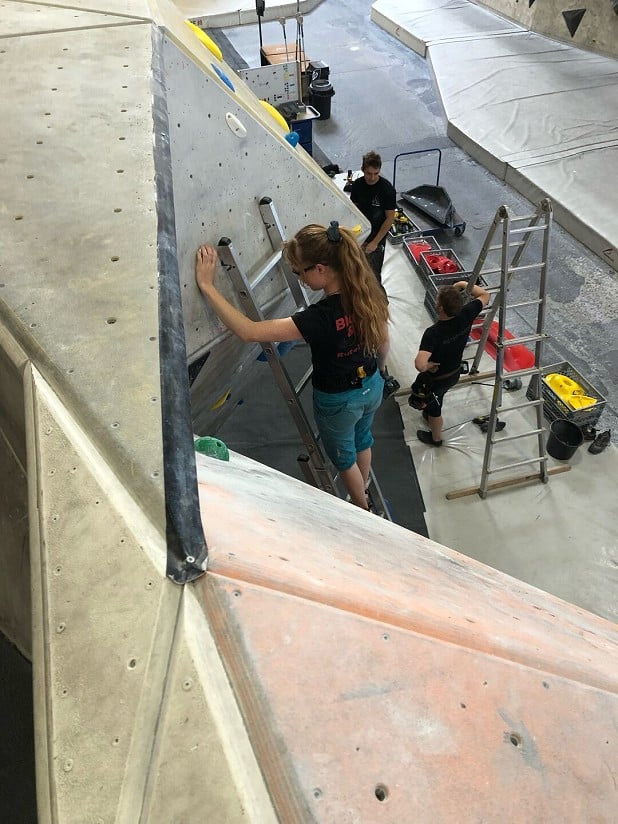
On the other hand, we as a community must also raise our expectations of what female route setters can do, and what they have to offer our sport. If women constantly have to ask to be included in certain aspects of their job, such as setting harder circuits or competitions, the job is not truly inclusive. This is a change that doesn't just need to occur amongst the male setting chiefs and colleagues we work with. Us women also need to have confidence in what we can achieve in this traditionally male profession. "Women need to be more confident in their own abilities," says Hélène.
I am for example often told by women in the gym that they would love to get into route setting, but can't see themselves as setters because they aren't strong enough, or don't understand climbing movement well enough. These are women who have been climbing a lot longer than some men I have worked with. Hélène hopes that as more women enter the profession, "more and more women will come to see setting as a job they can be great at."
This is part of the reason why Alise has been creating spaces where female route setters get to set together. "Women rarely get to set together," she says. "It is important for us to see other female setters, in order to mirror and grow." Learning from and with each other can act as a great way to build women's confidence in their own ability. Alise believes that "we need space to express ourselves as women, but not just for women. Creating a safe space means that everyone can express themselves better." Whether they take the form of workshops, route setting courses or informal gatherings, these spaces where diversity is not just accepted, but celebrated, are central to the collective empowerment of people who have traditionally been marginalised in the community.
While route setting is a job that has been around since the birth of indoor climbing gyms, it is a line of work that has only in recent years begun to be professionalised. In some ways, it feels like the community is at a tipping point. "Mindsets are changing," says Hélène. In time, she believes that route setting "will be seen as a job that is open to everyone." Right now however, it is important that we keep pushing to change the things that still need changing, so that the future of route setting can become less about gender, and more about the many other attributes that make a good setter.

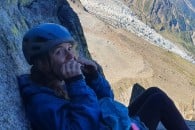

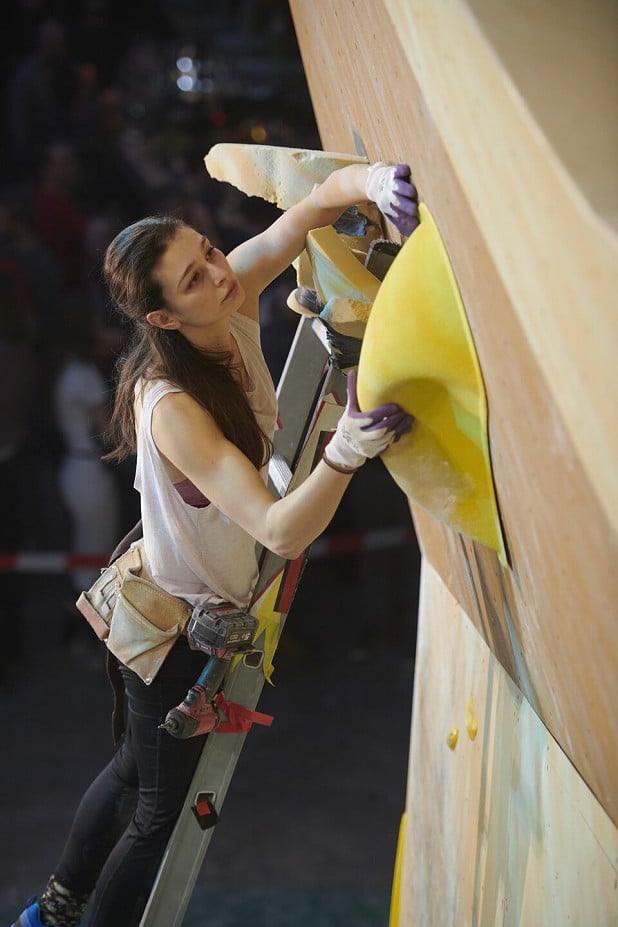













Comments
Short anecdote from the local lead wall: the chief route setter had put up a load of new routes and we had a great time trying for onsights and discussing the grading. One route I found outstandingly good, imaginatively set and mentally very challenging. I congratulated him on it and he told me that it was one of three routes set by a local female setter whom he‘d invited. Good luck to all women trying to get established in the setting world, we want more of that!
I'm all behind this, having climbed or attempted to climb problems set Holly Kilo Duce, formerly of The Arch in Bermondsey. As long as women aren't there to check the inclusivity box as some walls have done it can only bring greater diversity. There are so many good female climbers but I feel the pathway into setting is based on 'who's yer mate' and 'can you climb hard'? Are you in the club?
Climbing to a good standard is necessary, especially considering testing is a team effort. Many men can set well at grades they want to climb but are useless below F7A because they don't climb enough of those grades to create quality movement. I feel that we need more setters who bring an educational element to the line. Regardless to the grade, Holly would set problems that challenged the climber and made them think and importantly, return.
Nowhere near the standard of setting that these ladies are, but I have set routes for many years in the wall I worked in. I never found any barriers to me doing it, and all the experienced staff got trained to set ( it was a small staff team), so I did sometimes set with another woman.
I used to find it amusing that men would often say my routes were reachy (I am teeny weeny), when actually I had a lot of balancy moves, high steps and rock overs. My routes favoured flexibility and core strength.
Generally though, I think the customers liked having a range of route setters giving different styles of climbing to keep it varied.
I don't live near a wall now, so no longer working there, sadly. I enjoyed it!
From my perspective as a male setter which would also translate to my female colleagues is the longer term setting game.
Can this be a career? Can I afford to make a living, potentially have and raise a family, buy a house, be covered if I sustain a serious injury on the job?
A fair few setters might view this as a transitory gig before moving on to something long term, but folks like me that want to stick with it need to know that I can earn an actual living from it without destroying myself in the process.
Good article, thank you.
As a climber I don't inherently care about the gender of the setter as long as they genuinely do consider different climbers' body types (not just make it harder by making it reachier; also - which so often seems to go unnoticed - consider the fact that on a smaller body, holds from other routes, especially volumes, can actually really get in the way of the move). If more female setters can solve this, please do!
Also agree with the comment (albeit not really about gender) that a lot of setters are bloody lazy when it comes to lower grades or top rope. Please do include more interesting moves, not just reach and haul, reach and haul... I have a widely popular local wall where I just know that at 5'3" the moves on 5s or 6as will be boring but they'll also be exhausting (and much harder than the intended grade) because they're just reach, reach, no creativity.
Having just been out cragging on a weekend designed to get more women into the alpine, and watching my female instructors experience sexism from other climbers on both days, at two different crags, to which as professionals they have no real right of reply, my serious respect goes out to women in the industry.